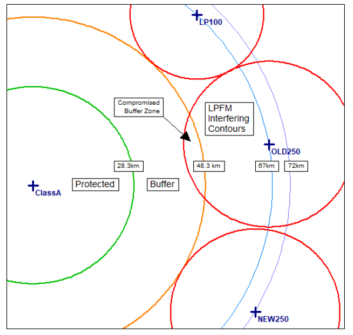This story is updated with additional information about a separate LPFM item at the FCC, subsequently adopted.
Advocates of low-power FM in the United States are hoping that the Federal Communications Commission will adopt a proposal to raise the maximum power level for many stations from 100 to 250 watts.
It’s not a new idea, but the commission recently opened a 30-day window for public comments on a fresh petition from REC Networks. This has led some to speculate that under a Democratic presidential administration, the FCC may be more willing to entertain the idea.
Details
The proposal to amend Parts 73 and 74 of the rules was submitted by Michelle Bradley, founder of REC Networks. Bradley says the dial can accommodate the change, noting that nearly two-thirds of LPFM stations are outside of the top 100 Nielsen Audio markets and that only 15% are in “deep-urban areas.”
In the summary, Bradley gave a brief history of the 250-watt debate and proposals since 2012 and why she is updating the proposal now, including changes to address concerns that had been raised about the earlier versions.
Among stations in support is WXOX(LP), “Art FM,” in Louisville, Ky. The station emailed its community calling this “a very exciting and unexpected opportunity that would help our low-power stations exponentially.” It asked supporters to file comments by the June 20 deadline.
“Discuss technical issues with the current 100 watts permitted by the FCC,” it suggested. “This includes inability to get FM signal beyond a few miles from the transmitter site and difficulty receiving FM signal inside certain buildings within this limited range. Discuss local populations that may be excluded by the low wattage.”
Specifically, the new proposal would would create an LP250 class of service with an effective service contour of about 4-1/2 miles, in addition to the current LP100 service.
There would be a second distance separation table for the new class that includes distances up to 9 km longer than the LP100 service.
Bradley said the proposal “fully respects the 20-kilometer buffer zone” and includes a suggested policy for upgrades on stations that are already second-adjacent short-spaced. She said the proposal does not add any new processes that would involve a contour study. It would allow class upgrades and downgrades as a minor change as long as other minor change criteria are met.
It also suggests a “launch window” method to manage an expected rush of stations wanting to upgrade. And it proposes a simplified RF radiation standard similar to the one used in LP100.
“In other words, this is simply like the LP100 service that has been around for the past 20 years, but just an add-on with the LP250 ‘numbers,’” Bradley wrote. “Or, in other words, simple.”
[An appendix to the proposal lists upgrade implications for all existing LPFMs, read that here.]
Bradley said the new proposal addresses past concerns about 250 watts. For example she submitted the accompanying image showing three hypothetical LPFM facilities.
 Their class-standard interfering contours are in red, the full-service station’s protected contour is in green and the buffer zone is in orange 20 kilometers outside of the green protected contour curve.
Their class-standard interfering contours are in red, the full-service station’s protected contour is in green and the buffer zone is in orange 20 kilometers outside of the green protected contour curve.
The LPFM curve at the top depicts an LP100 station under current rules. The middle curve (OLD250) depicts a method proposed earlier in which the buffer zone is penetrated to keep minimum distance separation. The bottom curve (NEW250) depicts what is being proposed.
By increasing the distances for the LP250 class on co- and first-adjacent channels, Bradley says the proposal satisfies the commission’s past concerns.
Comments can be submitted at the FCC comment system. Refer to Proceeding RM-11909.
Meanwhile the FCC shortly will vote on an “order on reconsideration” involving two other petitions. That order would “affirm” a maximum LPFM power of 100 watts along with other changes, but its text also makes note of the fresh proposal from REC Networks and that it is open for comments. [That item was subsequently adopted.]
An earlier version of this article stated incorrectly that the maximum height above average terrain for the new class would be 451 meters or 1,479 feet. It should have stated that with the addition of the LP250 class of service, no new LP100 stations would be allowed at HAATs above 451 meters as the service contour would exceed 5.6 km and the FCC does not license stations for less than one watt. The few existing LP100 stations above 451 meters would be permitted to continue as LP100 stations.







